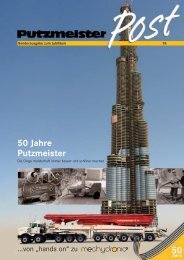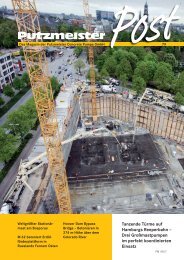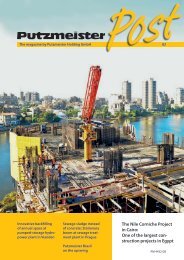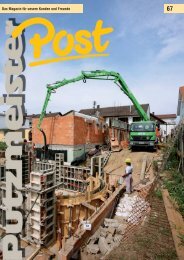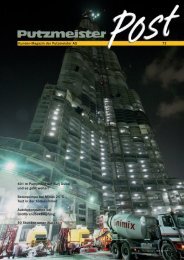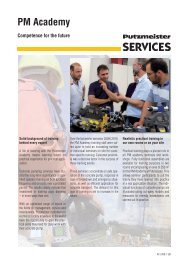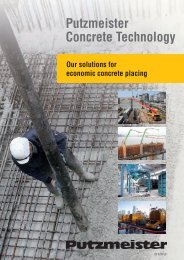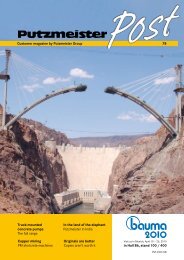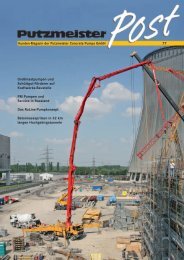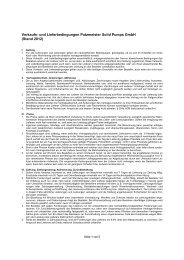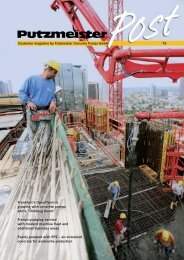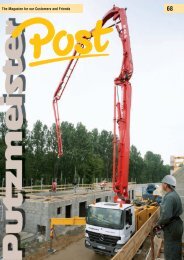The 4h pumping of Neufahrn: Large boom team places ... - Putzmeister
The 4h pumping of Neufahrn: Large boom team places ... - Putzmeister
The 4h pumping of Neufahrn: Large boom team places ... - Putzmeister
Create successful ePaper yourself
Turn your PDF publications into a flip-book with our unique Google optimized e-Paper software.
Underground Underground<br />
p <strong>The</strong> patented concrete paving machine when embedding the sleeper shoes<br />
between the concrete paving machine and<br />
the pump unit. <strong>The</strong> entire pipeline would<br />
therefore have to be made mobile. <strong>The</strong> pump<br />
unit consists <strong>of</strong> an electrically powered concrete<br />
pump and two mixing drums, whereby<br />
the fi rst one would be used to supply the<br />
system with fresh concrete, and the second<br />
one would provide the concrete for ensuring<br />
that a continuous concreting cycle could be<br />
maintained.<br />
Concreting train<br />
<strong>The</strong> concreting train consists <strong>of</strong> various railway<br />
wagons on which all <strong>of</strong> the necessary<br />
components for carrying out a continuous<br />
and smooth procedure are mounted (including<br />
the necessary cleaning and maintenance<br />
work). All systems are protected by an emergency<br />
power unit.<br />
Pump and delivery line<br />
<strong>The</strong> <strong>Putzmeister</strong> stationary concrete pump<br />
is on the third wagon, plus a small conveyor<br />
belt for feeding the concrete pump. In order<br />
to prevent the pump from drifting during<br />
the <strong>pumping</strong> procedure, the frame <strong>of</strong> the rail<br />
car is fi lled with concrete and the support<br />
legs <strong>of</strong> the pump are directly screwed to it.<br />
<strong>The</strong> pump can be operated using a cable-connected<br />
remote control during the <strong>pumping</strong><br />
process. <strong>The</strong> concrete is transported from<br />
the pump to the concrete paver up to 400 m<br />
away via a steel delivery line that is installed<br />
on special wagons. <strong>The</strong> maximum permitted<br />
concrete pressure <strong>of</strong> the delivery line is<br />
130 bar. <strong>The</strong> delivery line has a diameter<br />
<strong>of</strong> 125 mm and a wall thickness <strong>of</strong> 7.1 mm.<br />
Since the slab track in the Malmö city tunnel<br />
also has a long curve with a radius <strong>of</strong> 760 m,<br />
the line has been adapted accordingly in<br />
order to be able to run on the patented alignment<br />
system made by Rhomberg Bahntechnik.<br />
Non-critical load transmission was<br />
a challenge during dimensioning.<br />
Paving machine<br />
<strong>The</strong> patented paving machine is located at<br />
the end <strong>of</strong> the delivery line and consists <strong>of</strong><br />
an upstream working and transport platform<br />
and a hopper. <strong>The</strong> concrete is transported to<br />
the track bed via three special chutes. <strong>The</strong><br />
concrete is pre-smoothed using skimming<br />
boxes and then compressed using vibrators.<br />
Cleaning<br />
Particular attention was also paid to having<br />
an environmentally friendly disposal and<br />
cleaning concept that meets the strict regulations<br />
in Sweden. In order to clean the<br />
35 36<br />
p <strong>The</strong> main power supply is provided<br />
by a diesel unit with output <strong>of</strong> approx.<br />
400 kW that is equipped with a soot<br />
particle fi lter for operating in the tunnel.<br />
p <strong>The</strong> concrete pump is screwed to the<br />
superstructure <strong>of</strong> the railcar<br />
delivery line with water, a media separating<br />
device must fi rst be installed. This ensures<br />
that residual concrete and washing water do<br />
not mix. <strong>The</strong> residual concrete in the line can<br />
therefore still be laid in the track bed. <strong>The</strong><br />
media separation system consists <strong>of</strong> the combination<br />
<strong>of</strong> sponge ball – soaked cement bags<br />
– sponge ball – wash-out pig – sponge ball.<br />
Team success<br />
It was possible to successfully deal with this<br />
complex project by means <strong>of</strong> close collaboration<br />
between participating project partners<br />
Rhomberg, Eibinger and <strong>Putzmeister</strong>. Not<br />
least the competent service engineers from<br />
Eibinger and their involvement, along with<br />
the effi cient service contributed to the success<br />
<strong>of</strong> this new solution for supplying concrete.<br />
n<br />
Pre-deployment test run<br />
An initial test run <strong>of</strong> the tunnel concreting<br />
train for constructing the slab track<br />
in the Malmö city tunnel took place on<br />
06.08.2009 at the Rhomberg Bahntechnik<br />
test site.<br />
During the test run, 10 m 3 <strong>of</strong> concrete<br />
was laid in the prepared track bed using<br />
the concreting train. A stroke time <strong>of</strong> 4.2<br />
seconds was determined during the <strong>pumping</strong><br />
process, which represents a delivery<br />
rate <strong>of</strong> approx. 38 m 3 /h. <strong>The</strong> hydraulic<br />
pressure reached a maximum <strong>of</strong> approx.<br />
215 bar when this took place. Starting<br />
Slab track system<br />
A slab track (previously also referred<br />
to as a ballast-less track or ballast-less<br />
superstructure) is a railway line that is<br />
used in railway, road and underground<br />
train construction in which the ballast<br />
and the sleepers are replaced with a solid<br />
track structure made from concrete or<br />
asphalt.<br />
with a conveying distance <strong>of</strong> about 250 m,<br />
this results in a calculated friction coeffi -<br />
cient <strong>of</strong> 2.6. No more than 25 – 30 m 3 /h<br />
is required in the actual <strong>pumping</strong> process<br />
in Malmö, meaning that the required delivery<br />
capacity is therefore provided.<br />
In order to simulate the situation on site<br />
as realistically as possible, part <strong>of</strong> the<br />
slab track in Malmö was modelled in<br />
Dornbirn/Austria. <strong>The</strong> sleeper shoes <strong>of</strong><br />
the rails were embedded in concrete (see<br />
fi g. below).<br />
<strong>The</strong> mixer drum was fed with fresh concrete<br />
with a truck-mixer pump during the<br />
test.<br />
37 38 39<br />
At speeds <strong>of</strong> more than 200 km/h, it is<br />
particularly important to note that, as<br />
well as having better track stability, the<br />
maintenance costs <strong>of</strong> the slab track are<br />
signifi cantly less. It is more resistant to<br />
deformation and the effects <strong>of</strong> the weather,<br />
and track position problems (and<br />
therefore speed restriction sections) hardly<br />
ever occur. <strong>The</strong> slab track is expected<br />
to have a service life <strong>of</strong> at least 60 years.<br />
This increases the availability, reliability<br />
and pr<strong>of</strong>i tability <strong>of</strong> the railway line.<br />
40<br />
0 PM 4356 GB PM 4356 GB 1



